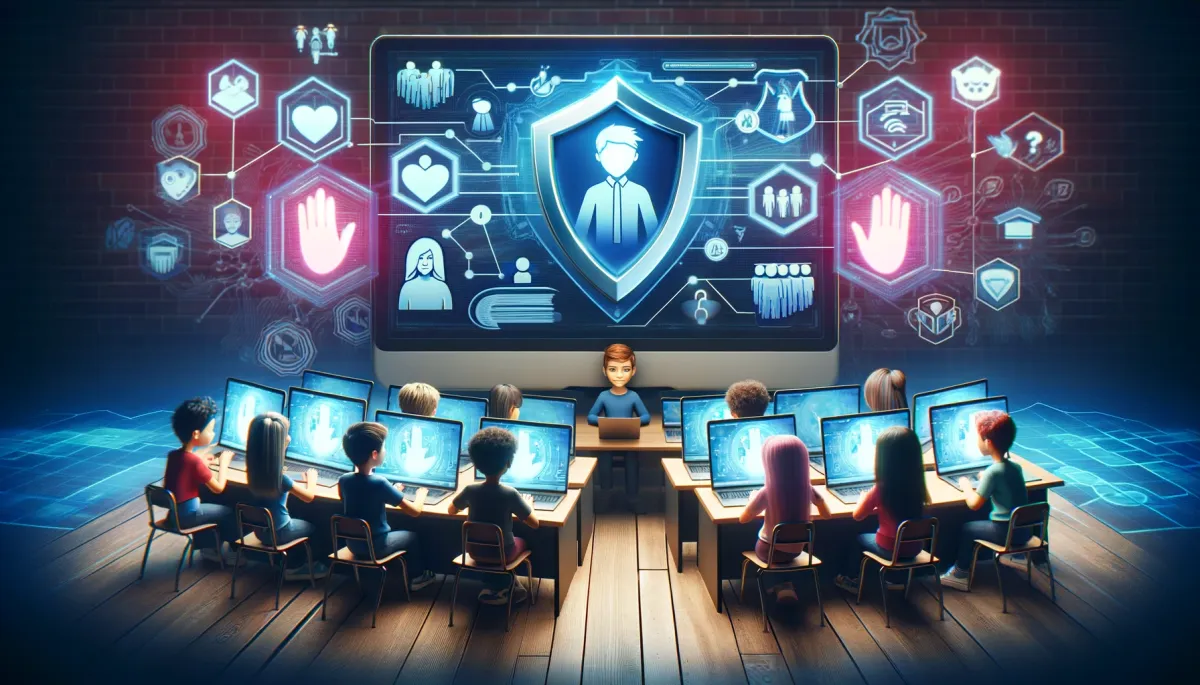Creating a Safe and Comfortable Online Learning Environment

Fanie Naude
CEO & Founder of Knowledgeable Tutor, Buznet Direct, YMC & Naude Consulting

Fanie Naude
CEO & Founder of Knowledgeable Tutor, Buznet Direct, YMC & Naude Consulting

Introduction: The Imperative of a Safe and Comfortable Online Learning Environment
In the digital age, where the boundaries of classrooms have expanded beyond four walls, the concept of a safe and comfortable learning environment has evolved. No longer confined to the physical space, safety and comfort now extend to the virtual classrooms where educators and students interact. As Albert Einstein once said, "The only source of knowledge is experience." And in today's world, that experience is increasingly becoming digital.
The importance of creating a secure and comfortable online learning environment cannot be overstated. It's not just about ensuring that the technology works; it's about creating a space where students feel safe to express themselves, where educators can teach without constraints, and where the process of learning can occur seamlessly.

The Basics of Online Safety
What Constitutes Online Safety?
Online safety is a multifaceted concept that goes beyond just having a secure password. It encompasses data protection, privacy, and the ethical use of technology. In the context of online tutoring, safety also includes creating an environment where students are free from harassment, bullying, and other forms of abuse.
- Data Protection: Ensuring that personal and academic data are secure is paramount. This involves using secure platforms that are compliant with data protection laws.
- Privacy: This refers to the confidentiality of the information shared during online sessions. Tutors must ensure that no unauthorized person can access these sessions.
- Ethical Use of Technology: This involves using technology responsibly. For instance, tutors should not exploit software to monitor students beyond what is necessary for educational purposes.
Importance of Data Protection and Privacy
In the age of data breaches and cyber threats, protecting students' data is not just ethical but also legal. According to a report by Cybersecurity Ventures, the damage costs due to cybercrime are expected to reach $10 trillion by 2025. These staggering numbers highlight the critical need for robust data protection strategies in online education.
- Legal Obligations: Laws such as the Children's Online Privacy Protection Act (COPPA) and the Family Educational Rights and Privacy Act (FERPA) mandate stringent data protection measures.
- Trust Factor: Ensuring data protection builds trust among students and parents, which is crucial for the success of any online tutoring platform.
- Academic Integrity: Secure data storage and transmission are essential to maintain the integrity of assessments and evaluations.
In summary, online safety is not a one-time setup but an ongoing process. It requires the active participation of tutors, students, and even parents to be truly effective. The next section will delve into the practical aspects of setting up secure platforms for online tutoring.

Setting Up Secure Platforms
Choosing Secure Software and Tools
In the realm of online tutoring, the choice of software and tools can make or break the security of your virtual classroom. As the saying goes, "A chain is only as strong as its weakest link." In this context, the weakest link could be an insecure platform that puts both tutors and students at risk. Therefore, it's crucial to opt for platforms that are renowned for their security features.
- Certifications: Look for platforms that are certified for security compliance. This could be ISO certifications or compliance with GDPR for European users.
- Multi-Factor Authentication (MFA): Platforms that offer MFA add an extra layer of security, making unauthorized access more difficult.
- Data Encryption: Ensure that the platform encrypts data both in transit and at rest.
For a deeper dive into understanding different online tutoring platforms and their security features, you can refer to our comprehensive guide on Understanding Different Online Tutoring Platforms.
Encryption and Password Protection
Encryption is the cornerstone of online safety. It scrambles data into an unreadable format, which can only be deciphered by someone who has the decryption key. In simpler terms, it's like a secret code that keeps your data safe.
- SSL Certificates: Ensure that the website you are using has an SSL certificate, indicated by 'https' in the URL.
- Strong Passwords: Encourage students and tutors to use strong, unique passwords. A combination of letters, numbers, and special characters is recommended.
- Password Managers: Using a password manager can help in securely storing and managing passwords.
By implementing robust encryption and password protection measures, you're not just adhering to best practices; you're building a fortress around your virtual classroom.

Online Etiquette and Ground Rules
Setting Guidelines for Video Conferencing
Video conferencing is the backbone of online tutoring. However, without proper guidelines, it can turn into a chaotic, unproductive environment. As Emily Post, the guru of etiquette, once said, "Manners are a sensitive awareness of the feelings of others." This awareness is crucial in a virtual setting.
- Camera Etiquette: Make it clear when cameras should be on or off. Some students may not be comfortable showing their surroundings.
- Mute Protocol: Teach students to mute themselves when not speaking to avoid background noise.
- Chat Guidelines: Set rules for using the chat function during a session to ensure it's used for academic purposes only.
For more insights into maintaining student engagement through effective video conferencing, you might find our article on Maintaining Student Engagement in Online Tutoring beneficial.
Importance of a Code of Conduct
A well-defined code of conduct serves as the constitution of your online classroom. It sets the behavioral standards and ethical guidelines that everyone is expected to follow.
- Respect for Diversity: The code should emphasize respect for diverse opinions, cultures, and backgrounds.
- Academic Integrity: Outline the consequences of plagiarism and cheating.
- Privacy: Include clauses that protect the privacy of both students and tutors.
A code of conduct is not just a set of rules; it's a statement of your educational philosophy. It sets the tone for what is acceptable and what is not, creating a harmonious learning environment for all involved.

Cyberbullying Prevention
Strategies to Limit Cyberbullying
In the digital realm, the specter of cyberbullying looms large. As educator and author James Lehman puts it, "Bullying is not a reflection of the victim's character, but rather a sign of the bully's lack of character." Online tutoring platforms are not immune to this menace, making it imperative to implement strategies that can effectively curb cyberbullying.
- Monitoring Tools: Utilize software that can flag inappropriate language or behavior during online sessions.
- Reporting Mechanism: Create an easy-to-use reporting system where students can anonymously report incidents.
- Immediate Action: Outline a clear procedure for dealing with reported incidents, including temporary or permanent bans for offenders.
For more information on ethical practices in online tutoring, including handling sensitive issues like cyberbullying, you can refer to our guide on Ethical Practices in Online Tutoring.
Case Studies on Effective Prevention
Real-world examples serve as powerful testimonials for the efficacy of anti-cyberbullying measures.
- School ABC: Implemented AI-based monitoring tools and saw a 40% reduction in online harassment cases within six months.
- Tutoring Service XYZ: Introduced a 'Guardian Angel' feature, allowing parents to silently observe sessions, resulting in a significant drop in bullying incidents.
These case studies not only validate the importance of proactive measures but also provide a roadmap for others to follow.

Inclusive Learning Environments
Strategies for Inclusivity
Inclusivity in online tutoring is not a luxury; it's a necessity. As the renowned educator Jane Elliott once said, "We don't have to be alike to be together. We just have to be thoughtful." Inclusivity ensures that every student, regardless of their background or abilities, has an equal opportunity to succeed.
- Language Options: Offer multi-language support for students who are non-native English speakers.
- Cultural Sensitivity: Be aware of cultural holidays and norms to avoid scheduling conflicts or misunderstandings.
- Special Needs Accommodations: Provide options for students with disabilities, such as screen readers or sign language interpreters.
For more on this, our article on Online Tutoring for Special Needs Students offers comprehensive insights.
Importance of Accessibility Features
Accessibility features are not just 'nice-to-haves'; they are 'must-haves' that make online learning equitable.
- Closed Captioning: This feature can be invaluable for students who are hard of hearing.
- Keyboard Shortcuts: These can aid students with mobility issues.
- Adjustable Fonts and Colors: Helpful for students with visual impairments.
By incorporating these features, you're not just complying with the Americans with Disabilities Act (ADA); you're also widening your reach and making education accessible to all.

Parental Involvement
How to Effectively Communicate with Parents
Parental involvement is a cornerstone of a child's educational journey, even in an online setting. As the African proverb goes, "It takes a village to raise a child," and in the context of online tutoring, parents are an integral part of that village.
- Regular Updates: Keep parents in the loop with regular progress reports and updates on their child's performance.
- Virtual Parent-Teacher Meetings: Schedule periodic online meetings to discuss any concerns or improvements.
- Transparency: Be open about the curriculum, teaching methods, and any issues that might affect the learning environment.
For more on this, you may find our article on Communicating Effectively with Parents of Students to be a valuable resource.
Importance of Parental Controls
Parental controls are not just about restricting content; they're about creating a safe digital space for children.
- Content Filters: Enable parents to set filters that block inappropriate content.
- Monitoring: Provide features that allow parents to monitor session times and activities.
- Time Limits: Allow parents to set time limits on tutoring sessions to prevent screen fatigue.
By involving parents and giving them the tools to protect their children, you're building a community of trust and safety.

Technical Requirements
Minimum Hardware and Software Requirements
The nuts and bolts of online tutoring—literally—are the hardware and software that make it possible. As the saying by Edward Teller goes, "The science of today is the technology of tomorrow." Ensuring that students and tutors are equipped with the right technology is crucial for a smooth learning experience.
- Computer Specifications: Outline the minimum RAM, processor speed, and hard drive space required.
- Software Compatibility: List the software that is compatible with your tutoring platform.
- Peripheral Requirements: Include any additional hardware like webcams, microphones, or drawing tablets that might be needed.
For a comprehensive list of tools and technology that can enhance your online tutoring experience, refer to our guide on Tools and Technology for Effective Online Tutoring.
Importance of Secure and Stable Internet Connections
A stable and secure internet connection is the lifeline of online tutoring. Without it, even the best-laid plans can go awry.
- Minimum Speed Requirements: Specify the minimum internet speed required for an uninterrupted session.
- VPN Recommendations: Suggest the use of Virtual Private Networks (VPNs) for added security.
- Backup Plans: Always have a backup plan, like switching to audio-only or rescheduling, in case of poor connectivity.
By setting these technical standards, you're not just ensuring a seamless learning experience; you're also fortifying the virtual walls of your online classroom.
Would you like to proceed with the next points in the article?

Emergency Protocols
What to Do in Case of a Security Breach
In the digital age, the question isn't if a security breach will happen, but when. As cybersecurity expert Bruce Schneier wisely said, "Security is not about risk elimination; it's about risk management." Therefore, having a robust emergency protocol is not just advisable; it's indispensable.
- Immediate Notification: Implement automated alerts that notify both tutors and students in the event of a security breach.
- Data Isolation: Outline steps for isolating compromised data to prevent further damage.
- Incident Reporting: Create a streamlined process for reporting the breach to relevant authorities.
For more insights on handling such critical situations, our article on How to Handle Technical Difficulties During Sessions can be a valuable resource.
Importance of Having a Contingency Plan
A contingency plan is your safety net, the protocol that kicks in when things go south. As the saying goes, "Hope for the best but prepare for the worst."
- Backup Software: Always have an alternative software option in case the primary platform fails.
- Data Recovery: Ensure that all session data is regularly backed up to facilitate easy recovery.
- Emergency Contacts: Maintain a list of emergency contacts for technical support, both for tutors and students.
By having a contingency plan, you're not just preparing for emergencies; you're also building confidence among your users that they are in a secure and well-managed environment.

Student Engagement
Strategies to Maintain Student Engagement
Engagement is the cornerstone of effective learning. As educational theorist Benjamin Bloom stated, "The purpose of education is to change the thoughts, feelings, and actions of students." In an online setting, maintaining student engagement can be particularly challenging but is crucial for successful outcomes.
- Interactive Tools: Utilize interactive whiteboards, quizzes, and real-time feedback to keep students engaged.
- Personalized Learning Paths: Tailor the curriculum to suit individual learning styles and paces.
- Gamification: Incorporate elements of game design in educational contexts to make learning more engaging.
For more on this, our guide on Maintaining Student Engagement in Online Tutoring offers a deep dive into effective strategies.
Importance of Regular Check-Ins
Regular check-ins serve as both a pulse check and a morale booster. They provide an opportunity to assess the effectiveness of the teaching methods and make necessary adjustments.
- Feedback Loops: Create mechanisms for students to provide feedback on the tutoring sessions.
- Progress Tracking: Use analytics to track student progress over time.
- Emotional Well-being: Regular check-ins can also serve to gauge the emotional and psychological state of the student, which is crucial for effective learning.
By incorporating regular check-ins, you're not just measuring academic progress; you're also building a rapport and a sense of community among your students.

Legal Considerations
Understanding COPPA and FERPA
In the labyrinth of online tutoring, legal considerations are the Minotaur that you must face. Ignorance of the law is no excuse, and as Oliver Wendell Holmes Jr. once said, "Ignorance of the law excuses no man."
- COPPA (Children's Online Privacy Protection Act): This U.S. law is designed to protect the privacy of children under 13. It requires parental consent for the collection of personal information.
- FERPA (Family Educational Rights and Privacy Act): This act protects the privacy of student education records and gives parents certain rights with respect to their children's education records.
For a deeper understanding of these laws, you might want to read our article on Ethical Practices in Online Tutoring.
Importance of Consent Forms
Consent forms are not just a formality; they are a legal necessity. They serve as a written agreement between the tutor, the student, and in the case of minors, the parents.
- Data Usage Consent: Explicitly state how the student's data will be used and stored.
- Session Recording Consent: If sessions are to be recorded, this needs to be clearly stated and agreed upon.
- Academic Honesty Agreement: A clause that ensures the student understands the importance of academic integrity.

Monitoring and Feedback
Tools for Monitoring Student Activity
Monitoring is not about surveillance; it's about guidance and improvement. As management guru Peter Drucker said, "What gets measured gets managed."
- Analytics Tools: Use analytics to track student engagement, participation, and performance.
- Screen Sharing: Utilize screen sharing tools to monitor real-time activity during sessions.
- Automated Reports: Generate automated reports that summarize each session's key metrics.
For more on this, our guide on Tools and Technology for Effective Online Tutoring offers a comprehensive look at monitoring tools.
Importance of Regular Feedback Loops
Feedback is the breakfast of champions, as Ken Blanchard would say. Regular feedback loops are essential for continuous improvement and are a cornerstone of effective online tutoring.
- Student Surveys: Periodic surveys can provide invaluable insights into the student's perspective.
- Parent-Teacher Conferences: Regular meetings with parents can offer a more holistic view of a student's progress.
- Peer Reviews: Encourage students to provide feedback on each other's performance, fostering a culture of collective growth.
By incorporating regular feedback loops, you're not just enhancing the educational experience; you're also building a culture of continuous improvement and accountability.

Teacher Training
Importance of Training Teachers for Online Safety
The adage "A chain is only as strong as its weakest link" rings true in the context of online safety in education. Teachers are the frontline defenders in this digital realm. As John C. Maxwell aptly puts it, "A leader is one who knows the way, goes the way, and shows the way."
- Cybersecurity Training: Teachers should be well-versed in basic cybersecurity protocols to protect both themselves and their students.
- Ethical Conduct: A comprehensive understanding of ethical considerations, such as data privacy and academic honesty, is crucial.
For those looking to bolster their understanding of online safety, our article on Ethical Practices in Online Tutoring serves as an excellent resource.
Case Studies on Effective Training Programs
Real-world examples serve as invaluable learning tools. Case studies offer a lens through which theoretical concepts are brought to life, providing a narrative that aids in understanding the practical application of training programs.
- K-12 Cybersecurity Training Program: A program that has significantly reduced cybersecurity incidents in schools.
- Educause's Higher Education Program: Known for its robust training modules on data privacy and ethical conduct.
For more insights into effective training programs, you may find our guide on Improving Your Teaching Skills: Tips for Online Tutors to be of great value.

Community Building
Strategies for Building a Safe Online Community
In the words of Henry Ford, "Coming together is a beginning; keeping together is progress; working together is success." A safe online community doesn't just happen; it's built through concerted effort and strategic planning.
- Moderated Forums: Create online spaces where students can interact, but make sure these are moderated to prevent any form of harassment or bullying.
- Collaborative Projects: Encourage students to work together on projects, fostering a sense of community and shared responsibility.
For more on this, our article on Maintaining Student Engagement in Online Tutoring provides a deeper dive into community-building strategies.
Importance of Group Activities and Forums
Group activities and forums serve as the digital playgrounds and town squares of the online educational world. They offer a space for social learning, which, as Albert Bandura's Social Learning Theory suggests, is a potent form of education.
- Interactive Quizzes: These can be done in groups to make learning more interactive and fun.
- Discussion Boards: A place for students to discuss lessons, share resources, and even debate on relevant topics.
By incorporating these elements, you're not just teaching; you're creating a vibrant, interactive, and safe learning community.

Mental Health Considerations
Strategies for Mental Well-Being
The mind is not a vessel to be filled, but a fire to be kindled," said Plutarch, emphasizing the importance of mental well-being in the learning process. In an online environment, the absence of physical interaction can sometimes lead to feelings of isolation and stress. Therefore, mental health considerations are not just an add-on but a necessity.
- Mindfulness Activities: Incorporating short mindfulness exercises can help students focus better and reduce anxiety.
- Regular Breaks: Scheduling short breaks during long sessions can prevent burnout and improve overall well-being.
For tutors who are keen on understanding the nuances of maintaining mental well-being while teaching online, our guide on Maintaining Your Mental Health as an Online Tutor offers valuable insights.
Importance of Breaks and Relaxation Techniques
The significance of breaks and relaxation cannot be overstated. As Leonardo da Vinci once said, "Every now and then go away, have a little relaxation, for when you come back to your work your judgment will be surer."
- Pomodoro Technique: A time management method that involves short bursts of concentrated work followed by a brief break.
- Deep Breathing: Simple yet effective, deep breathing exercises can be a quick way to relieve stress.

Future Trends
Upcoming Technologies for Safer Online Learning
The future is not something we enter; it's something we create," remarked Leonard I. Sweet. The landscape of online education is ever-evolving, and staying updated with the latest trends is not just advisable but essential.
- AI-Driven Monitoring Systems: These systems can detect unusual behavior or language that might indicate cyberbullying or harassment.
- Blockchain for Credentials: A secure and immutable way to store educational credentials, reducing the risk of fraud.
For those interested in the future landscape of online tutoring, our article on Future of Online Tutoring: Trends to Watch provides a comprehensive overview.
Importance of Staying Updated
In the words of Alvin Toffler, "The illiterate of the 21st century will not be those who cannot read and write, but those who cannot learn, unlearn, and relearn." Staying updated is not just about adopting the latest technologies but also about understanding the evolving best practices in online safety, community building, and mental health.
- Webinars and Online Courses: Regularly participating in educational webinars can keep you updated with the latest trends and technologies.
- Peer Reviews and Feedback: Constructive criticism from peers can provide new perspectives and insights into improving your online tutoring methods.

Conclusion
In the digital age, where online tutoring is not just an option but a necessity, creating a safe and comfortable online learning environment is paramount. From understanding the basics of online safety to setting up secure platforms, from parental involvement to teacher training, each facet contributes to a holistic, secure, and inclusive learning experience. As Benjamin Franklin wisely said, "An investment in knowledge pays the best interest." Investing in a secure and comfortable online learning environment is an investment in the future, ensuring that education is not just disseminated but is impactful, inclusive, and safe.

Frequently Asked Questions (FAQ)
What are the basic requirements for online safety in a learning environment?
Online safety in a learning environment primarily involves data protection, privacy, and secure communication channels. Encryption and password protection are essential.
How can tutors set up secure platforms for online learning?
Tutors should opt for software and tools that offer end-to-end encryption and robust password protection. For more information, you can read our guide on tools and technology for effective online tutoring.
What are the guidelines for online etiquette and ground rules?
Setting up guidelines for video conferencing and a code of conduct for online interactions is crucial. This ensures respectful and focused learning sessions.
How can cyberbullying be prevented in online learning environments?
Strategies include setting up strict codes of conduct, monitoring online interactions, and providing a safe space for students to report issues.
How can one create an inclusive online learning environment?
Inclusivity can be achieved by incorporating accessibility features like subtitles, sign language interpreters, and screen readers. For more on this, read our article on online tutoring for special needs students.
What role do parents play in online learning?
Parents can help by setting up parental controls, monitoring their child's online activity, and maintaining open communication with tutors. For more tips, read communicating effectively with parents of students.
What should be done in case of a security breach?
Having an emergency protocol and a contingency plan is crucial. Immediate steps should include changing passwords and notifying all stakeholders.
What are the legal considerations for online tutoring?
Understanding and complying with laws like COPPA and FERPA is essential. Consent forms for data collection and usage are also important.
How can tutors monitor student activity and provide feedback?
Various tools allow for the monitoring of student activity. Regular feedback loops are essential for continuous improvement.
What training do teachers need for ensuring online safety?
Teachers should undergo training programs that focus on online safety, ethical practices, and the use of secure platforms.
What are the future trends in creating a safer online learning environment?
Upcoming technologies like AI-driven monitoring tools and advanced encryption methods will play a significant role in enhancing online safety.
For more in-depth information, you can refer to the articles and tips provided by LinkedIn, WGU, and IES.

